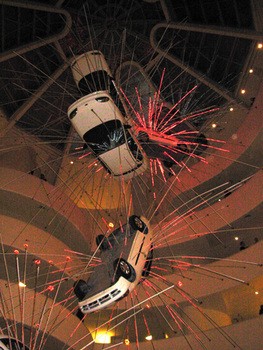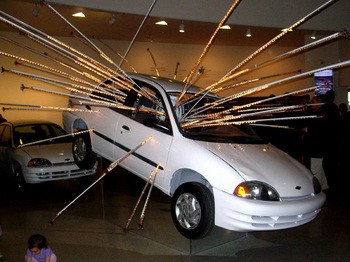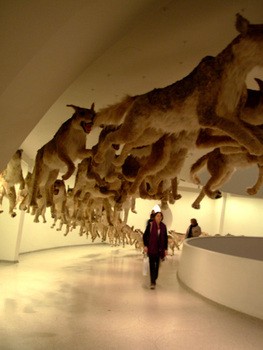Cai Guo-Qiang at the Guggenheim
Snap, Crackle, and Pop
By: Charles Giuliano - Dec 26, 2012
Cai Guo-Qiang: I Want to Believe
The Guggenheim Museum
First Published April 4, 2008 in Maverick Arts
Spectacle- That which is exposed or exhibited to public view, particularly if it is held worthy of unusual notice. 1. A grand display or exhibition, pageant, parade, show, especially a stage-play with elaborate scenic effects. 2. An unwelcome or deplorable exhibition, a painful sight; as the spectacle of a ruined man.
Spectacular- Of or pertaining to a spectacle, characterized by a grand scenic display, as, a spectacular review.
The exhibition by the Chinese born artist ( 1957) “Cai Guo-Qiang: I Want to Believe” which fills the ramps and most of the ancillary galleries of the Guggenheim Museum in New York City, through May 28, evokes all of the nuances of the term spectacle and its modifier, spectacular.
The installation features a range of work from numerous stuffed animals, flipping cars suspended in the central space with flickering appendages of lights. There are enormous drawings resembling Chinese calligraphy and landscapes but executed by controlled use of explosives. We encounter a warren of social realist clay sculptures in varying states of execution and disintegration. Areas are set aside for viewing videos of globally produced fireworks displays as performance events, with precise definitions of related terms. The works are intended to evoke a wow reaction from slack jawed visitors gawking and gaping at this “spectacular” exhibition.
As with an earlier, large scale installation at the Massachusetts Museum of Contemporary Art, including several flipping cars in the museum’s largest space, we reflect on the difference between art and spectacle. Just how is one distinct from the other and what happens when the boundaries are blurred?
It is rather like viewing one of the late films in the “Star Wars” saga, or a Chinese based action film like “Crouching Tiger, Hidden Dragon,” in which fighters leap over buildings and dance through the tree tops engaging in mortal combat. Despite “spectacular” special effects one is left with the gnawing misgivings about the depth of the experience.
Similarly, while perambulating the ramps of the Guggenheim, I felt like one of Pirandello’s characters in search of an author; a plot, or any real sense of meaning and insight above and beyond what filled the eyes.
These misgiving are exacerbated by efforts to understand in proper perspective and proportion the aspects of a culture remotely different from the paradigms of Western art.
Encountering unfamiliar terrain, rather than being entangled in difficult and divisive issues, there is a tendency to grant a free pass to the creator. We accept the spectacle and invest it with ad hoc meaning in a manner that, arguably, one would not allow to say, an artist like Matthew Barney. The meaning of Barney’s work may be similarly esoteric but it is a less politically loaded terrain to navigate.
To critique the work of Cai is daunting. How to get a proper fix on the work such as “New York’s Rent Collection Courtyard” The first version of which was exhibited at the Venice Biennale in 1999? Its range of life-size, social realist sculptures executed by a team of Chinese artists and artisans, requires some understanding of the agit-prop of the Maoist era.
The project was originally created in 1965, reproduced widely in China, and reflects its cultural revolution. Recreated today does it retains its original intentionality of exposing the crushing repressions of the ruling class before the revolution? Or, is it now presented, with some irony, as an artifact of academic, political art? Is the fact that the figures are allowed to crumble and decay meant as a subversive spoof of its initial aspects as propaganda? Just where does the artist position himself about an art form signifying the tragedies and atrocities of Mao and the purges of the Gang of Four?
What to make of the seven white cars flipping and careening down from the top of the rotunda of the museum? From these sedans are spikes of flashing lights suggesting a multiple vehicle crash and explosions.
There is intense virtual impact and sense of wonder about how the installers managed to rig these vehicles into place. Recently, we discussed the complex and challenging installation of this work at Mass MoCA with its director of installations, Richard Criddle. It represented one of his greatest achievements and the recreation of the piece in the Guggenheim represents an even greater degree of difficulty. While this is a challenge for an art museum, arguably, this is not so daunting in the context of a film production or theme park. So what is quite stunning in one context is routine business in another. This enforces the ambiguity of boundaries between fine art and spectacle.
On the ground level of the museum is a long wall dedicated to a multi projector video of a float with exploding fireworks cruising through Times Square at night. Here the conflation of art, film/ video and special effects is explicit. It intrigued and puzzled me in the Mass MoCA show and no less so again at the Guggenheim.
Winding around the rotunda in one segment of the ramp is a double line of 99, life like, rampaging wolves. Their muzzles gasp for breath with snarling teeth and wagging tongues pant for air in extreme exertion. At the end of this headlong charge of angry wolves they come crashing into a plexiglass wall. While fascinating what does it mean? Surely there is a metaphor but it was not readily apparent. This is a similar response to the group of stuffed tigers hurling about pierced with numerous arrows.
The response to the several video monitors displaying the fireworks performances and demonstrations of how they are used to create “drawings” is more accessible. We are more accustomed to responding to fireworks as bursts of color, sound, fury and light. On the Fourth of July, or New Year’s Eve, a display of fireworks is little more than an expression of celebration. We don’t look for meaning beyond the spectacle. In China, where it began centuries ago, we may ascribe to it deeper and more traditional layers of meaning.
In an era of globalization it is complex to sort out just what is Eastern or Western about contemporary art. While Cai Guo-Qiang is an artist of Chinese birth, training and heritage, he is also clearly fluent with Western ideas and culture.
Just where are the edges and boundaries? Surely this becomes ever more problematic as artists are seen internationally. Mass MoCA, for example, has a current exhibition “Eastern Standards, Western Artists in China.” It focuses on American and European artists who have spent time in China and created works based on that influence and experience.
Whirling down the ramp of the Guggenheim there was the dichotomy of feeling visually seduced as well as a disoriented search for meaning. Despite the daunting complexities few artists have more thoroughly exploited the demanding space of the Frank Lloyd Wright building.
Arguably, this is among the most successful installations in the history of the Guggenheim.




